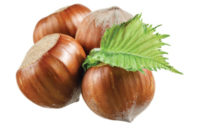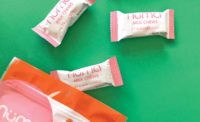Nowadays, it’s all about what’s healthy. More and more, people are attracted to words like “organic,” “natural” and “non-GMO.” And, they don’t want additives in their food.
It’s a “wake-up call,” says Bob Moore, president, RDM International. A wake-up call saying the nation wants something different.
“The funny thing is,” says Moore, “we’re trying to get back to where we were in the 1950s, when food didn’t have all these additives.”
And, of course, in the 1950s, people didn’t eat as much candy. According to the PMCA, candy consumption in the past decade was up 10 lbs. per capita from the 1950s. So it makes sense that if current trends tend toward getting back to where we were 60 years ago, people’s faith in confections would waver.
In Europe, the confectionery market is predicted to have a negative compound annual growth rate from 2013 to 2018. Government and social pressure is expected to take its toll on marketing, and it’s largely thanks to the bad rap sweets have received. While candy consumption has increased in the last 60 years, obesity and diabetes rates have risen as well and the candy industry gets blamed for many of these health issues.
So how does the industry adapt to these changing perspectives? By upping its game and hopping on board the health bandwagon. Adding nuts and fruits to candy is a clear and conscious way of saying the confectionery industry also wants to become healthier — and it’s not an empty promise either.
The Journal of the Academy of Nutrition and Dietetics published a study saying daily blueberry consumption helps reduce blood pressure and arterial stiffness, possibly preventing progression to hypertension. Tart cherries, on the other hand, soothe arthritis symptoms, ease muscle pain after workouts and enhance sleep, says Jeff Manning, chief marketing officer, Cherry Marketing Institute.
“They add a nutrition halo, especially when paired with dark chocolate,” he adds.
Nuts also pack a powerful nutritional punch. Just 1 oz. of almonds contains 6 g. of protein, 4 g. of fiber and 160 cal., according to the Almond Board of California. Hazelnuts are similarly nutritious, containing 2.7 g. of fiber per ounce and high folate content that decreases risk of cardiovascular disease and depression, says the Hazelnut Marketing Board.
“People overall have a positive look at fruit and nuts,” says Moore. And that positive attitude has driven the addition of both to candy. Using fruit juice concentrate as a sweetener is becoming more popular, says Moore, and nutrition bars often contain dried fruit. Not only that, but certain fruits have distinctive tastes that all but demand a pairing with candy.
“The unique sweet-tart taste of tart cherries makes them the perfect addition to a variety of flavors and textures,” says Manning. “In addition to their nutritional value, their sour flavor profile pairs beautifully with confections.”
And flavor, of course, is just as important. Polly Owen, director, Hazelnut Marketing Board, says that flavor is key when consumers decide what foods to buy.
“We believe consumers will always choose to indulge in foods that they believe taste great,” she says. When it comes to hazelnuts, Owen says they also pair exceptionally well with chocolate, which means taste combined with the nutritious value of hazelnuts projects added benefit to an indulgence. For Owen, though, that’s not all. “They’re also beautiful,” she says.
But in an ever-changing industry, success naturally demands innovation.
“Healthy snacking is on the rise, and companies are looking for ways to add function and some sort of nutritional benefit to candy while maintaining flavor,” says Justin Gold, founder, Justin’s. Nuts. Peanut butter makes for a more satisfying treat when it’s added to chocolate, and by balancing sweetness while adding texture complexity, it creates a whole new sensory experience, he adds.
At Justin’s, innovation comes in the form of reimagined chocolate peanut butter cups: organic, Rainbow Alliance-certified, gluten-free and filled with Justin’s’ staple artisanal peanut butter. It’s a classic treat with a spin that satisfies consumers’ growing fascination with getting back to more natural culinary roots.
But there’s more. Recently, Inclusion Technologies announced the release of its Nadanut Naturals line, all natural, clean-labeled and non-GMO. It’s the new line of existing Nadanut technology, a nut analog designed to mimic real nuts in texture, color, flavor, size and shape.
In a currently volatile nut market, it’s an allergen-free, lower-cost option. Last year’s crop freeze in Turkey and this year’s California drought have driven nut supplies down and prices up.
“From a market perspective, it’s a really good time for our technology,” says Dennis Reid, v.p. of sales and marketing, Inclusion Technologies.
Not only are nut prices high, but nut allergies have become increasingly problematic. A survey conducted by Rich Products Corp. shows that two thirds of parents consider potential nut allergies when purchasing snacks and 17 percent hesitate to provide snacks for events due to allergy concerns.
Nadanut, designed to compositionally match the nutritional attributes of nuts, is the answer to the nut-free market.
“When you take our product and apply it to a cluster or turtle or candy bar, you’ve got such a highly flavored system,” says Reid. “The nut is really applying the eye appeal, the texture, the crunch and the complimentary flavor.”
In short, because Nadanut has all those sensory attributes, it’s hard to tell it’s not a nut.
Working with flavor houses to develop all-natural, nut-free nut flavors is a challenge, says Reid, but Nadanut is near equivalent with nuts in taste, fiber and protein composition. But the toughest part is explaining to marketers the concept of a “nut-free nut.” Nut-free confectionery plants can be wary, and it’s a matter of explaining that Nadanut will let them maintain a nut-free environment while creating nut-like products.
“You’ve got to get to the right person to get them to understand, because it’s something they haven’t really had access to,” says Reid.
The innovation doesn’t stop there though. Inclusion Technologies is working on creating a Nadanut butter that can be used as a filling in confectionery.
“We made a Nadanut ‘Nutella knockoff,’ a Nadanut hazelnut spread,” says Reid. And although the spread isn’t quite ready yet, it’s still a cool concept.
In today’s increasingly health-conscious market, it’s new ideas like this that could pay off. Companies and consumers alike are more and more open-minded.
“Nobody has a product like ours and that puts us in a very good position,” says Reid. “We’re so excited.”











